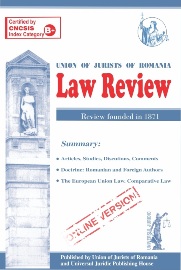DYNAMICS AND TOOLS OF ‘UPWARD CONVERGENCE’ IN THE EU SOCIAL POLICY: ASSESSING THE EUROPEAN STATES’ PERFORMANCE UNDER THE EUROPEAN PILLAR OF SOCIAL RIGHTS
DYNAMICS AND TOOLS OF ‘UPWARD CONVERGENCE’ IN THE EU SOCIAL POLICY: ASSESSING THE EUROPEAN STATES’ PERFORMANCE UNDER THE EUROPEAN PILLAR OF SOCIAL RIGHTS
Author(s): Cristina PătrașcuSubject(s): Law, Constitution, Jurisprudence, Civil Law, Human Rights and Humanitarian Law, Public Law, Government/Political systems, EU-Legislation
Published by: Universul Juridic
Keywords: Public Law; European Union Law; convergence; government performance; social policy; European Pillar of Social Rights;
Summary/Abstract: The present article proposes an analysis of the various ‘facets’ of convergence with a special focus on the concept of ‘upward convergence’ which was set in place to ensure a better coordination of the EU and its members in the field of social policy. Ensuring a stronger socioeconomic convergence to achieve better living standards for the European citizens and reduce inequalities, particularly after the economic crisis that has shaken Europe, has become a top priority for the EU. In order to realize this objective, the EU uses a variety of tools and mechanisms, both legal and financial. One of the newest and highly debated legal instruments created by the EU is the European Pillar of Social Rights. The article offers a comparative analysis of the levels of performance as well as of the concrete results obtained by various governments in their efforts to implement the objectives of EU social policy. The analysis starts from the assumption that the European states have different levels of economic development and resilience, a fact that makes even more difficult a strong convergence and synchronicity in the implementation of these measures. Our research intends to call attention to the fact that EU’s legislation and policies have a positive impact on the performance of the governments in the socioeconomic field. The methods used are both qualitative and quantitative, consisting of an evaluation and a brief comparative study based on the scientific literature in the field, but also of the presentation of data and indicators that clearly show the levels of performance and the achievements of different governments. The main general conclusion that may be formulated is that on the one hand, the EU is making efforts at establishing all the necessary instruments to enhance convergence. On the other hand, between countries there are both convergent and divergent evolutions and countries may be grouped according to the level(s) of their accomplishments (which differ from case to case) which makes it obvious that some of them do need more time and (harder) work to reach the established targets.
Journal: Law Review
- Issue Year: 2019
- Issue No: Supliment2
- Page Range: 67-78
- Page Count: 12
- Language: English
- Content File-PDF

